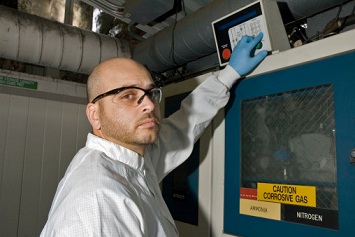Are the workers in your facility prepared to recognize the dangers posed by corrosive chemicals? If this question makes you hesitate for even a second, you should give them the information they need to protect themselves.

leezsnow / iStock / Getty Images Plus / Getty Images
Workers may know that corrosive materials can be hazardous to their skin and eyes, but are they aware that these substances are also highly reactive when they come into contact with certain other substances? Or that corrosives can be extremely hazardous inside their body, too?
Corrosives pose multiple hazards to workers, which is why they must follow safe work practices, wear protective equipment, and know how to respond to exposure situations.
The purpose of today’s Advisor is to provide you with some training information on corrosives that you can use for a safety meeting, a handout, or some other employee safety communication.
What’s Corrosive?
The category of “corrosive chemicals” includes:
- Acids, like hydrochloric acid and sulfuric acid; and
- Alkalis, like potassium and sodium hydroxide, which are also called “bases” or “caustics.”
Employees may be exposed to corrosives through:
- Inhalation. Breathing even small amounts of corrosive mists or fumes can cause nose, mouth, and throat irritation, and larger amounts can cause bronchitis or severe lung damage.
- Ingestion. Most people would not intentionally swallow a corrosive liquid, but there have been instances—some fatal—when workers accidentally did so.
- Eye contact. Splashing or spraying corrosives, or corrosive mists, can cause eye damage. Bases are particularly dangerous to the eyes.
- Skin contact. Corrosive liquids or mists can cause contact dermatitis, burns, or blisters.
Physical Hazards
It’s crucial to point out to employees that besides health hazards, corrosives are highly reactive. They can cause fires, explosions, or violent exothermic (heat-releasing) reactions (these often look like an explosion) if they come in contact with water or other chemicals or with combustible materials.
Workers should keep in mind that:
- Acids react with many metals to release hydrogen, a highly flammable gas that can ignite in air.
- Some acids are strong oxidizing agents (chemicals that support combustion by releasing oxygen) and can react violently when they come in contact with organic or other oxidizable materials.
- Alkaline chemicals can be strongly reactive. Alkali solids in particular react violently to contact with water; this is why sodium metal is stored in oil.
Safe Work Practices
Employees should use these safe work practices like these to protect themselves from corrosives:
- Always check both the label and the SDS to learn the hazards of the corrosive you are handling or working near.
- Make sure corrosive and other chemical containers are properly labeled.
- Report any missing or illegible labels.
- Store corrosives properly. Acids and alkalis should be stored separately because they can react violently with one another.
- Move containers of corrosives with care to prevent spills and exposures.
- Use ventilation to reduce airborne exposures.
Personal Protective Equipment
Also, employees must wear proper PPE when working with corrosives, including:
- Chemical-resistant safety goggles to protect eyes from splashing or spraying liquids and corrosive mists
- Face-shield to protect fact from splashes (but employees should remember that a face shield without goggles is never proper protection)
- Protective gloves, corrosive-resistant footwear and protective clothing (corrosives can eat through many materials) to prevent skin contact
First Aid
Make sure employees know how to respond effectively in the event of an exposure to a corrosive chemical:
- If a corrosive chemical gets in the eyes, immediately flush eyes with water for at least 15 minutes. Seek prompt medical treatment, especially for alkali exposures.
- If a corrosive gets on the skin or contacts mucous membranes, immediately flush affected skin under a safety drench shower, and remove any clothing beneath the level of contact.
- If a corrosive chemical is accidentally swallowed, do not induce vomiting. This could do additional damage to the esophagus, throat, and mouth.
- Drink water to dilute the chemical, and immediately seek medical treatment.
